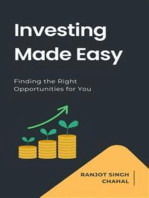Assignment 2 Fin MNGT Complete
Assignment 2 Fin MNGT Complete
Uploaded by
ronellCopyright:
Available Formats
Assignment 2 Fin MNGT Complete
Assignment 2 Fin MNGT Complete
Uploaded by
ronellOriginal Title
Copyright
Available Formats
Share this document
Did you find this document useful?
Is this content inappropriate?
Copyright:
Available Formats
Assignment 2 Fin MNGT Complete
Assignment 2 Fin MNGT Complete
Uploaded by
ronellCopyright:
Available Formats
Financial Management 2
FIM2246/2020/2/A1
Assignment 1
Student Name: RK Pauchcowrie
Student No: 156859
Question One
RK Pauchcowrie 156859 7805050240089
Ten Strategies used by Finance Managers
1) Reduce supplier credit costs.
2) Take advantage of supplier discounts
3) Renegotiating with suppliers for preferential pricing
4) Improve on debt collection
5) Reduce debt
6) Eliminate early payment discounts to customers
7) Invest in technology
8) Invest in quality human capital
9) Implement strategic plans
10) Proper credit screening of customers
Question 2
Differentiate between money and capital markets.
Money can be described as an asset and a generally acceptable means of payment in the
sale and purchase of goods and services. Money can also be held for a period of time and be
used to finance future payments (store of value), can be used as a common medium of
exchange, can be used to measure and record the value of products and assets (unit of
account). The money market is a component of the financial market for assets involved in
short term borrowing, lending, buying and selling within a year or less. Trading is done over
the counter and is wholesale. Money market instruments include collateral loans, deposits,
certificate of deposits, bills of exchange, repurchase agreements.
The Capital market encompasses both the trade in stocks and bonds. They are longer-term
assets bought by financial institutions, professional brokers and individual investors, as
opposed to money markets which is a trade in short term debt. Where the money market is
a short-term lender solution, the capital market is geared towards long term investing.
Companies issue stocks to raise money to raise funds to grow their business and investors
buy these shares to be a part of the growth.
While the money market is less risky the capital market is potentially more rewarding.
Question 3
RK Pauchcowrie 156859 7805050240089
Examine common stock as a major source of capital
Common stock represents shares entitling their holder to dividends depending on the
profit / loss of the Company. There are numerous ways to raise capital for your business.
One of the most popular is issuing of ordinary shares (common stock) to investors willing to
part with their funds in exchange for shares in your Company.
Some advantages include:
Voting Rights – Common shareholders can participate in internal corporate
governance through voting. Shareholders have a certain amount of say in how the
business is run and can participate in important decision making. Each common
share equals one vote.
Gains – A straight forward way for investors to benefit and generate income,
although profits are not guaranteed. Shares can also be sold at a higher price than it
was purchased. Shareholders can reinvest profits or receive them as income.
Limited Liability – Common shareholders are protected against the financial
obligations of the Company and are only liable for their share’s value. Common
shareholders also gain access to new share issues before the public.
Disadvantages:
Common shareholders are the last to be paid. If the Company liquidates you are
most likely to lose your investment. Preferred shareholders get paid before ordinary
shareholders and if there in nothing left common shareholders do not get paid.
It is difficult to exercise control over your investment. You have limited or no control
over decisions taken. You are subject to the will of the majority stockholders.
It is a risky investment as there can be no dividends paid depending on the
Companies profit / loss.
Question 4
4.1 Give reasons why cash management is important to any business?
Cash Management refers to the collection, concentration and disbursement of cash. It
includes the Company’s liquidity, its management of cash and its short-term investment
strategies.
It is important for new and growing businesses, as cash flow can be problematic even if a
small business has numerous clients, offers a superior product or has a good reputation
within the industry.
Companies that have cash flow problems have no margin of safety in case of unexpected
expenses. They may also have problems securing funding for innovation or expansion.
RK Pauchcowrie 156859 7805050240089
Poor cash flow makes is difficult to hire and retain good employees as payment of wages
and salaries are affected when cash flow is poorly managed.
Cash is the lifeblood of a store. Without cash available for salaries, stock, expenses etc a
crisis is imminent.
4.2 Outline the Beta Coefficient of a firm and outline the determinants of Beta
In finance the Beta of a stock or portfolio is a number describing the relationship of its
returns with that of the financial market as a whole.
The Beta Coefficient is a key parameter in the capital asset pricing model (CAPM). It
measures the part of the asset’s statistical variance that cannot be mitigated by the
diversification provided by the portfolio of many risky assets, because of the correlation of
its returns with the returns of the other assets that are in the portfolio.
The variance and covariance (Beta), depend on 3 fundamental factors:
1) The nature of the business – All economies experience business cycles. The earnings
of some companies fluctuate more and their earnings grow during the growth phase
and decline during the contraction phase. The implication is that if a firm’s earnings
are more sensitive to business conditions, they have a high Beta, however, a
Company’s earnings may be highly variable but it may not have a high Beta
2) Operating Leverage – Refers to the use of fixed costs. The degree of operating
leverage is defined as the change in an economy’s earnings before interest and tax
due to a change in sales. If all other things remain the same companies with higher
operating leverage are more-risky.
3) Financial Leverage – Refers to debt in a firm’s capital structure. Firms that have debt
in the capital structure is called leverage firms. Since financial leverage increases the
firm’s financial risk, it will increase the equity Beta of that firm.
Question 5
Critically examine the CAPM model clearly outlining what it entails, assumptions &
criticisms
The Capital Asset Pricing Model (CAPM) is a model in finance that is used to price risky
assets. It was developed by William Sharpe in 1968.
For CAPM to hold it uses a set of assumptions:
1) Perfect markets
2) A world of no taxes
3) A world of no transaction costs
RK Pauchcowrie 156859 7805050240089
4) Homogenous expectations by investors
5) Investors are rational and risk averse.
6) There is a risk-free asset that earns a risk-free rate
Using these assumptions, the theory distinguishes between the systematic risk and
unsystematic risk of an asset. CAPM highlights that the unsystematic risk of an asset is
irrelevant in the pricing of risky assets because it can be diversified away through combining
assets which are negatively correlated to each other. It highlights that the only risk that is
relevant in pricing is the systematic risk which is market-wide risk caused by changes in the
macro-economic fundamentals such as interest rates, exchange rates and inflation.
This brings about the Beta of an asset which is a measure of an asset’s systematic risk. The
model thus arrives at the equation for pricing risky assets using the risk-free rate and the
systematic risk of an asset. According to CAPM the return in a risky asset is given by the
following equation:
Ri = Rf = βi(Rm-Rf) where:
RF – is the risk-free rate that investors are given to compensate for the time value of money
Βi – Is the measure of an assets systematic risk
Rm – is the return on the market and hence (Rm-Rf) is the risk premium that investors are
rewarded in the market for investing in risky assets.
The limitations of CAPM that limit its applicability in the real world are that it is based on
unrealistic assumptions.
1) In the real world there is no risk-free asset
2) In the real-world taxes are very relevant and investors are charged transactions costs
3) Not all investors are risk averse and some investors actually pay to be exposed to risk
like gambling
4) All investors do not have homogenous expectations.
CAPM is criticised for its unrealistic assumptions as discussed above. Also, the fact that
CAPM is based on historical data e.g. the beta is calculated using historical data. Also, the
beta of a firm has been found not to be stationary. It changes over time and hence the
expected returns calculated based on CAPM may differ greatly with actual returns.
RK Pauchcowrie 156859 7805050240089
You might also like
- The Subtle Art of Not Giving a F*ck: A Counterintuitive Approach to Living a Good LifeFrom EverandThe Subtle Art of Not Giving a F*ck: A Counterintuitive Approach to Living a Good LifeRating: 4 out of 5 stars4/5 (5891)
- The Gifts of Imperfection: Let Go of Who You Think You're Supposed to Be and Embrace Who You AreFrom EverandThe Gifts of Imperfection: Let Go of Who You Think You're Supposed to Be and Embrace Who You AreRating: 4 out of 5 stars4/5 (1103)
- Never Split the Difference: Negotiating As If Your Life Depended On ItFrom EverandNever Split the Difference: Negotiating As If Your Life Depended On ItRating: 4.5 out of 5 stars4.5/5 (870)
- Grit: The Power of Passion and PerseveranceFrom EverandGrit: The Power of Passion and PerseveranceRating: 4 out of 5 stars4/5 (597)
- Hidden Figures: The American Dream and the Untold Story of the Black Women Mathematicians Who Helped Win the Space RaceFrom EverandHidden Figures: The American Dream and the Untold Story of the Black Women Mathematicians Who Helped Win the Space RaceRating: 4 out of 5 stars4/5 (912)
- Shoe Dog: A Memoir by the Creator of NikeFrom EverandShoe Dog: A Memoir by the Creator of NikeRating: 4.5 out of 5 stars4.5/5 (543)
- The Hard Thing About Hard Things: Building a Business When There Are No Easy AnswersFrom EverandThe Hard Thing About Hard Things: Building a Business When There Are No Easy AnswersRating: 4.5 out of 5 stars4.5/5 (352)
- Elon Musk: Tesla, SpaceX, and the Quest for a Fantastic FutureFrom EverandElon Musk: Tesla, SpaceX, and the Quest for a Fantastic FutureRating: 4.5 out of 5 stars4.5/5 (474)
- Her Body and Other Parties: StoriesFrom EverandHer Body and Other Parties: StoriesRating: 4 out of 5 stars4/5 (830)
- The Sympathizer: A Novel (Pulitzer Prize for Fiction)From EverandThe Sympathizer: A Novel (Pulitzer Prize for Fiction)Rating: 4.5 out of 5 stars4.5/5 (122)
- The Little Book of Hygge: Danish Secrets to Happy LivingFrom EverandThe Little Book of Hygge: Danish Secrets to Happy LivingRating: 3.5 out of 5 stars3.5/5 (414)
- The Emperor of All Maladies: A Biography of CancerFrom EverandThe Emperor of All Maladies: A Biography of CancerRating: 4.5 out of 5 stars4.5/5 (272)
- The Yellow House: A Memoir (2019 National Book Award Winner)From EverandThe Yellow House: A Memoir (2019 National Book Award Winner)Rating: 4 out of 5 stars4/5 (99)
- The World Is Flat 3.0: A Brief History of the Twenty-first CenturyFrom EverandThe World Is Flat 3.0: A Brief History of the Twenty-first CenturyRating: 3.5 out of 5 stars3.5/5 (2270)
- Creating Shareholder Value: A Guide For Managers And InvestorsFrom EverandCreating Shareholder Value: A Guide For Managers And InvestorsRating: 4.5 out of 5 stars4.5/5 (9)
- Devil in the Grove: Thurgood Marshall, the Groveland Boys, and the Dawn of a New AmericaFrom EverandDevil in the Grove: Thurgood Marshall, the Groveland Boys, and the Dawn of a New AmericaRating: 4.5 out of 5 stars4.5/5 (269)
- Team of Rivals: The Political Genius of Abraham LincolnFrom EverandTeam of Rivals: The Political Genius of Abraham LincolnRating: 4.5 out of 5 stars4.5/5 (235)
- A Heartbreaking Work Of Staggering Genius: A Memoir Based on a True StoryFrom EverandA Heartbreaking Work Of Staggering Genius: A Memoir Based on a True StoryRating: 3.5 out of 5 stars3.5/5 (232)
- Bharti Airtel BalsheetDocument2 pagesBharti Airtel BalsheetBrock LoganNo ratings yet
- Your Results For "Chapter 2": Overall Score: 100% of 12 QuestionsDocument99 pagesYour Results For "Chapter 2": Overall Score: 100% of 12 QuestionsTuan Anh Lee100% (1)
- On Fire: The (Burning) Case for a Green New DealFrom EverandOn Fire: The (Burning) Case for a Green New DealRating: 4 out of 5 stars4/5 (74)
- Business WorkbookDocument19 pagesBusiness Workbookjltarley33% (3)
- Project On DemonetizationDocument51 pagesProject On DemonetizationSwarnajeet Gaekwad80% (106)
- Investments Workbook: Principles of Portfolio and Equity AnalysisFrom EverandInvestments Workbook: Principles of Portfolio and Equity AnalysisRating: 4 out of 5 stars4/5 (1)
- A simple approach to bond trading: The introductory guide to bond investments and their portfolio managementFrom EverandA simple approach to bond trading: The introductory guide to bond investments and their portfolio managementRating: 5 out of 5 stars5/5 (1)
- The Unwinding: An Inner History of the New AmericaFrom EverandThe Unwinding: An Inner History of the New AmericaRating: 4 out of 5 stars4/5 (45)
- Mastering the Market: A Comprehensive Guide to Successful Stock InvestingFrom EverandMastering the Market: A Comprehensive Guide to Successful Stock InvestingNo ratings yet
- Analytical Corporate Valuation: Fundamental Analysis, Asset Pricing, and Company ValuationFrom EverandAnalytical Corporate Valuation: Fundamental Analysis, Asset Pricing, and Company ValuationNo ratings yet
- Summary of Michael J. Mauboussin & Alfred Rappaport's Expectations InvestingFrom EverandSummary of Michael J. Mauboussin & Alfred Rappaport's Expectations InvestingNo ratings yet
- How Beginners Achieve Financial Success: A Guide to Understanding Risk and ReturnFrom EverandHow Beginners Achieve Financial Success: A Guide to Understanding Risk and ReturnNo ratings yet
- Portfolio Management - Part 2: Portfolio Management, #2From EverandPortfolio Management - Part 2: Portfolio Management, #2Rating: 5 out of 5 stars5/5 (9)
- DIVIDEND INVESTING: Maximizing Returns while Minimizing Risk through Selective Stock Selection and Diversification (2023 Guide for Beginners)From EverandDIVIDEND INVESTING: Maximizing Returns while Minimizing Risk through Selective Stock Selection and Diversification (2023 Guide for Beginners)No ratings yet
- Dividend Investing: Passive Income and Growth Investing for BeginnersFrom EverandDividend Investing: Passive Income and Growth Investing for BeginnersNo ratings yet
- Unlocking the Secrets of Value Investing: Building Wealth Through the Stock MarketFrom EverandUnlocking the Secrets of Value Investing: Building Wealth Through the Stock MarketNo ratings yet
- Mastering the Markets: Advanced Trading Strategies for Success and Ethical Trading PracticesFrom EverandMastering the Markets: Advanced Trading Strategies for Success and Ethical Trading PracticesNo ratings yet
- Dividend Growth Investing: The Ultimate Investing Guide. Learn Effective Strategies to Create Passive Income for Your Future.From EverandDividend Growth Investing: The Ultimate Investing Guide. Learn Effective Strategies to Create Passive Income for Your Future.No ratings yet
- Investment Valuation: Learn Proven Methods For Determining Asset Value And Taking The Right Investing DecisionsFrom EverandInvestment Valuation: Learn Proven Methods For Determining Asset Value And Taking The Right Investing DecisionsNo ratings yet
- How to Make Money in Stocks: A Successful Strategy for Prosperous and Challenging TimesFrom EverandHow to Make Money in Stocks: A Successful Strategy for Prosperous and Challenging TimesNo ratings yet
- Textbook of Urgent Care Management: Chapter 46, Urgent Care Center FinancingFrom EverandTextbook of Urgent Care Management: Chapter 46, Urgent Care Center FinancingNo ratings yet
- The Finace Master: What you Need to Know to Achieve Lasting Financial FreedomFrom EverandThe Finace Master: What you Need to Know to Achieve Lasting Financial FreedomNo ratings yet
- An Investment Journey II The Essential Tool Kit: Building A Successful Portfolio With Stock FundamentalsFrom EverandAn Investment Journey II The Essential Tool Kit: Building A Successful Portfolio With Stock FundamentalsNo ratings yet
- Business Opportunity Thinking: Building a Sustainable, Diversified BusinessFrom EverandBusiness Opportunity Thinking: Building a Sustainable, Diversified BusinessNo ratings yet
- Investments Profitability, Time Value & Risk Analysis: Guidelines for Individuals and CorporationsFrom EverandInvestments Profitability, Time Value & Risk Analysis: Guidelines for Individuals and CorporationsNo ratings yet
- Investing Made Easy: Finding the Right Opportunities for YouFrom EverandInvesting Made Easy: Finding the Right Opportunities for YouNo ratings yet
- Summary of Bruce C. Greenwald, Judd Kahn & Paul D. Sonkin's Value InvestingFrom EverandSummary of Bruce C. Greenwald, Judd Kahn & Paul D. Sonkin's Value InvestingNo ratings yet
- Stock Market Starter: A Beginner's Guide to Investing: Building Wealth One Share at a TimeFrom EverandStock Market Starter: A Beginner's Guide to Investing: Building Wealth One Share at a TimeNo ratings yet
- Ethical Valuation: Navigating the Future of Startup InvestmentsFrom EverandEthical Valuation: Navigating the Future of Startup InvestmentsNo ratings yet
- Balance Sheet Management: Squeezing Extra Profits and Cash from Your BusinessFrom EverandBalance Sheet Management: Squeezing Extra Profits and Cash from Your BusinessNo ratings yet
- Steps Academics Can Take Now to Protect and Grow Their PortfoliosFrom EverandSteps Academics Can Take Now to Protect and Grow Their PortfoliosNo ratings yet
- How To Begin Investing In The Stock Market: Obtaining Financial FreedomFrom EverandHow To Begin Investing In The Stock Market: Obtaining Financial FreedomNo ratings yet
- Saving Capitalism From Short-Termism: How to Build Long-Term Value and Take Back Our Financial FutureFrom EverandSaving Capitalism From Short-Termism: How to Build Long-Term Value and Take Back Our Financial FutureRating: 3.5 out of 5 stars3.5/5 (2)
- Dividend Investing for Beginners & DummiesFrom EverandDividend Investing for Beginners & DummiesRating: 5 out of 5 stars5/5 (2)
- Dividend Investing for Beginners: The Ultimate Guide to Double-Digit Your Returns. Learn How to Create Passive Income and Get One Step Closer to Your Financial Freedom.From EverandDividend Investing for Beginners: The Ultimate Guide to Double-Digit Your Returns. Learn How to Create Passive Income and Get One Step Closer to Your Financial Freedom.No ratings yet
- FOREX - The Recession Proof Business of The 21st Century - ReportDocument33 pagesFOREX - The Recession Proof Business of The 21st Century - ReportneveenNo ratings yet
- Basic Financial StatementsDocument44 pagesBasic Financial Statementsfikru terfaNo ratings yet
- Financial Analysis of Maruti Suzuki, Tata Motors and Mahindra and MahindraDocument7 pagesFinancial Analysis of Maruti Suzuki, Tata Motors and Mahindra and MahindraGarry Josan100% (1)
- About HGSDocument3 pagesAbout HGSNagnath B HalgondeNo ratings yet
- Ghani Glass 2007Document39 pagesGhani Glass 2007Muhammad BilalNo ratings yet
- Chinas Industrial Water MarketDocument58 pagesChinas Industrial Water Marketsunil_snathNo ratings yet
- Annual Report 2008-09Document158 pagesAnnual Report 2008-09Megha GuptaNo ratings yet
- The Jeepney BusinessDocument4 pagesThe Jeepney BusinessRomel Balico BalucioNo ratings yet
- Study Material (1) .OdsDocument322 pagesStudy Material (1) .OdsmichelleNo ratings yet
- Sourin Mukherjee (PG-10-084)Document17 pagesSourin Mukherjee (PG-10-084)ppoooopopopooopopNo ratings yet
- FAR ReviewDocument9 pagesFAR ReviewJude Vincent VittoNo ratings yet
- Ciptadana Equity Market Outlook 2020 Final PDFDocument270 pagesCiptadana Equity Market Outlook 2020 Final PDFBangkit ZuasNo ratings yet
- NestleDocument7 pagesNestleloga priyavimal rajNo ratings yet
- Deduction Under Capital GainsDocument14 pagesDeduction Under Capital GainsHemal PanchalNo ratings yet
- CFA Level 3 FormulaDocument6 pagesCFA Level 3 FormulaRishabh SardaNo ratings yet
- 12 Trial Balance and RectificationDocument9 pages12 Trial Balance and RectificationZaheer Ahmed SwatiNo ratings yet
- Maya Gold & Silver and Guy Goulet Exploring MoroccoDocument4 pagesMaya Gold & Silver and Guy Goulet Exploring MoroccoguygouletNo ratings yet
- Raghu Ram Chittibommala Company Law Problems and SolutionsDocument39 pagesRaghu Ram Chittibommala Company Law Problems and SolutionsCh SubrahmanyamNo ratings yet
- CIT Exercises - June 2020 - ACEDocument16 pagesCIT Exercises - June 2020 - ACEKHUÊ TRẦN ÁINo ratings yet
- Shareholder Activists at Friendly IcecreamDocument24 pagesShareholder Activists at Friendly IcecreamAshutosh PandeyNo ratings yet
- FinMan Unit 2 Tutorial-Financial Statement Analysis Revised Aug2021Document5 pagesFinMan Unit 2 Tutorial-Financial Statement Analysis Revised Aug2021Debbie DebzNo ratings yet
- Listing of SecuritiesDocument5 pagesListing of SecuritiesticktacktoeNo ratings yet
- Helpful WebSites and Other Sources For Strategic AnalysisDocument6 pagesHelpful WebSites and Other Sources For Strategic Analysistaghavi1347No ratings yet
- KPTL Annual Report 2017 18Document252 pagesKPTL Annual Report 2017 18Saurabh PatelNo ratings yet
- 100 Renewal Energy Tri Fold ACCESSDocument6 pages100 Renewal Energy Tri Fold ACCESSquintqasNo ratings yet
- Soap Market Study 2000Document39 pagesSoap Market Study 2000Totie LumanglasNo ratings yet


























































































































